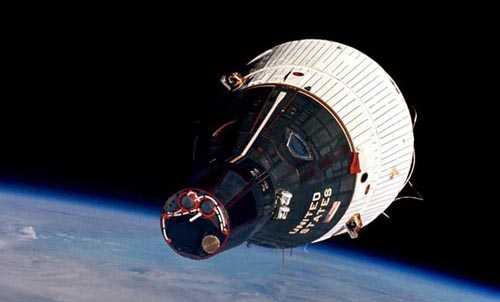The spacecraft paved the way for the era of exploring the Moon
50 years ago, the Gemini spacecraft was first launched into orbit, paving the way for later Moon research activities.
Spaceship launch history on the moon
On June 5 , 1966 , astronaut Gene Cernan on the Gemini ship of the US Aerospace Agency (NASA) tested AMU - one of the most dangerous devices ever flown into space. The astronaut pusher (AMU) is designed as a shoulder backpack, powered by a rocket engine. In order to leave AMU, Cernan had to leave the Gemini cabin, walk out of space around the rear section, open the struts and arms, activating a series of oxygen and fuel valves.

Gemini's programs are considered to pave the way for the study of the Moon, space shuttle and life on the International Space Station (ISS).(Photo: NASA)
Faced with the heat of the outfit, the glass covered with dust and heavy breathing, the astronaut struggled to make this weird machine work. Later, he described the experience as a space walk from hell . " You are handcuffed in a pressure suit, which makes you unable to move, go around the world at a speed of 28,000 km / h and cannot see anything ," Cernan describes.
Fortunately for Cernan, the AMU preparation was so cumbersome and annoying that the control center canceled the plan before the astronaut could boot. Finally, Cernan returned to the spacecraft. With bulky metal pants, he had to press himself painfully as he sat on the chair and closed the shutter door on the hull.
In NASA's Gemini program, many incidents have occurred such as mechanical failure, malfunction when deploying the connecting module. However, Gemini's missions have shown more contributions than risks. Surprisingly, the crew returned to Earth safely.Cernan returned to space for the second time in Apollo's mission and went into history when he became the last person to set foot on the Moon.
For two years and six months, between pioneering Mercury flights and Moon landing, 12 Gemini missions (10 human programs) were conducted to test the technology of bringing people to the Moon's surface. and return to Earth safely.

Gemini can survive after falling into the sea like Mercury spacecraft.(Photo: NASA)
Every flight is a challenge
Gemini takes walks in space , connecting two spacecraft and challenges while in long-term orbit. Flight test for space food, conditions for supporting life and fuel cells.
" Every flight is a new effort, a challenge. I thought my flight was a failure, but it turned out we learned a great lesson, helping us keep moving forward and successful implementation of the Moon , "Cernan said.
Gemini was designed to resemble all other spacecraft, tasked with bringing two astronauts into orbit. Inside the conical chamber are two seats, a table of equipment and a console, which resides inside a car. Above each chair is a hatch, where astronauts come out and walk in space.
With flight features, spacecraft is equipped with an electronic guide computer, propulsion and radar. One of Gemini's main tasks is to demonstrate that spacecraft can meet and connect in orbit. That a feat involves many complex calculations, precise navigation and positioning. Without these capabilities, Apollo has no prospect of success.
"The movements on previous spacecraft like Mercury or Soviet vehicles were decided in advance and inaccurate, with Gemini, they required complete control of the vehicle and this was never done. "We have done it before ," said Ed Stewart, managing director at the Rocket and Space Center in Huntsville, Alabama.
The first attempt at the " rendezvous" on the intended trajectory was made between Gemini 5 and an unmanned probe, but must be canceled after the pusher failed. The plan then assigned to Gemini 6 also fell into the same situation because the target ship exploded shortly after launch. NASA continued with Gemini 7 with the crew, Frank Borman and Jim Lovell.
50 years ago, Gemini's first mission was launched into orbit . 4.5 years later, humans set foot on the Moon. Gemini is considered to pave the way for research activities on the Earth's natural satellite, space shuttle and life on the International Space Station (ISS).
- China launches spacecraft to explore the dark areas of the Moon
- LADEE spacecraft flew into Moon's orbit
- NASA announced 8,400 photos of the process of exploring the Moon
- Two spacecraft about to plunge into the moon to
- NASA prepares to explore the beautiful moon of Jupiter
- Interesting things few people know about the Moon
- Official: Americans will return to the Moon
- He provides moon travel services
- China will bring the probe to the dark side of the Moon in 2018
- NASA returned to the moon
- Japan abandoned the mission of exploring the Moon
- American private company takes spacecraft to the Moon
 The most famous scientific failures in history
The most famous scientific failures in history The son carries the 'bad gene' of genius Albert Einstein
The son carries the 'bad gene' of genius Albert Einstein Isaac Newton
Isaac Newton The birth of the microscope
The birth of the microscope